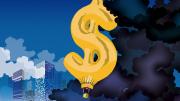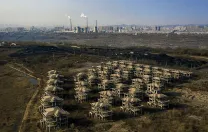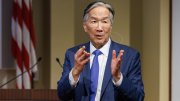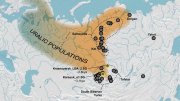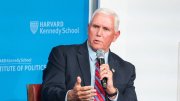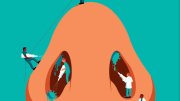By most measures, the U.S. economy weathered the pandemic recession. But even as life returns to normal for most Americans, the recovery remains hard to interpret. Policymakers face conflicting signals: job growth, for example, that would normally presage a period of prosperity, paired with declining output of goods and services that typically foreshadow recession. At the same time, high inflation suggests the economy is overheated. The Federal Reserve has responded by swiftly raising interest rates—and the odds of recession.
The contradictions make it difficult to chart a sure-footed path forward. Domestically, how much of the post-pandemic restructuring of the labor market is permanent? And around the world, how long will the food- and energy-supply shocks unleashed by Russia’s war on Ukraine last? How should policymakers respond—particularly because the impacts will be distributed unevenly in the United States and globally? Lower-income service workers, for example, who bore the brunt of the pandemic, have enjoyed the biggest gains in employment and income during the recovery—but are probably the most vulnerable to job loss in a recession. Harvard-affiliated experts in domestic monetary and fiscal policy, international economics and monetary policy, and the politics of international economic relations, emphasize the great uncertainties in this moment and the heightened risk of missteps.
Job 1: Controlling Inflation
First, “We need to get inflation under control,” says Aetna professor of the practice of economic policy Jason Furman, former chair of the Obama administration’s Council of Economic Advisers. He is joined by most observers in setting that priority. But Furman notes that, given the economic circumstances caused by the COVID-19 pandemic, doing so is no simple matter. The Federal Reserve, which is responsible for monetary policy, faces an acute dilemma, he says: “Normally, the central bank can either worry about inflation or worry about recession. Rarely has it needed to worry about both.” Inflation is a tax that hits everyone in the pocketbook, eroding incomes and harming, in particular, low-paid workers who spend the largest proportion of their income on essentials such as food, clothing, and housing. Less affected are people who own assets, which rise in value during inflationary periods, and homeowners who have borrowed at fixed rates below inflation, because the relative value of their debt declines. But a recession could lead millions of lower-income workers to lose their jobs.
As recently as this past March, to bolster the pandemic-stressed economy, the Fed held its federal funds rate (the rate at which banks loan each other money) at around zero percent. But when inflation spiked, exacerbated by soaring energy prices caused by the Ukraine war, the central bank pivoted. By July, year-over-year inflation had reached 8.5 percent—more than four times the Fed’s 2 percent target—prompting aggressive rate increases, with more to come.
That speed is warranted, says Furman, because of the risk that inflation will become entrenched in the economy. “Does it become self-perpetuating, as wage increases lead to price increases, and price increases lead to wage increases? Expectations matter,” he emphasizes. “As businesses set prices and workers negotiate wages, if they think they are in a world of consistently high inflation, you’ll see more indexation of contracts, and firms reacting by saying, ‘If everyone else is going to raise prices, I’ll raise mine, too.’ And it becomes a bit self-fulfilling. So, you’d like expectations to be anchored.” Even if the effect does not spiral out of control, he says, it could keep inflation high for a sustained period of time. “That, to me, is the biggest concern. If you look at most forecasters and financial markets [which still price long-term mortgage rates, for instance, well below inflation], they expect inflation to pretty steadily go away,” Furman says. “I am much more skeptical.”
Not all inflation is sticky. Food and energy prices, which account for 2.5 percent of the 8.5 percent annual figure (to July), result in “very little pass-through,” Furman explains, “because as jet fuel or chicken breasts become more expensive, airlines or restaurants raise their prices. And because people are also spending much more on gasoline than they were a year ago, they can’t afford to eat out as much or take as frequent vacations. So rising energy prices reduce demand for other things. And that relieves some of the inflationary pressure. So, when you look at the direct pass-through, and the behavioral effects, they’re close to canceling out.”
Might the remaining annual inflation (5.8 percent excluding food and energy as of this writing) dissipate as supply problems and worker shortages ease? Furman explains that the post-pandemic U.S. labor force is missing about 3.5 million workers: an estimated 2 million people “who would have immigrated under normal patterns but didn’t because of Trump and COVID” and another 1.5 million people who are absent from the workforce, he says, “for reasons we don’t yet understand. It could be long COVID or that they retired early.” (About 260,000 people of working age have died of COVID—too few to explain the labor shortfall.) Neither explanation points to easy solutions. And the absence of workers presents a double-edged inflationary threat: employers bid more for potential employees, and labor shortages exacerbate supply-chain congestion that began during the most intense phases of the pandemic. Employers emphatically continue to hire: there are twice as many job openings as there are people seeking employment, and from March through August, the U.S. economy added an average of 381,000 jobs monthly.
Amid the disrupted labor supply, demand for services spiked dramatically in 2022. During the pandemic, explains Stanfield professor of international peace Jeffry Frieden, as people stopped spending “on commuting, travel, medical care, and visits to the hairdresser or the nail salon, the savings rate shot up from 5 percent to 25 percent.” Many workers were still being paid, and saving their stimulus money, too. But “In the past nine months, as things have started to open up, they’ve been spending those savings at very high levels. I think the Fed is concerned that raising interest rates may have limited impact on that kind of demand, when so many people have so much money in the bank.” As with labor constraints, the unusual savings suggest no quick end to inflationary factors.
Although higher rates may not immediately dampen all consumer spending, the Federal Reserve’s action has already increased costs for mortgages and business loans. That, in turn, will lead to less homebuilding and the associated sustained consumer spending and reduce business investment. Ultimately, higher rates thus slow economic growth and reduce inflation—and raise the risk of recession. Some economists think that the U.S. unemployment rate (currently about 3.7 percent) will have to exceed 6 percent to bring inflation back down to reasonable levels—with direct, severe impacts for millions of workers and their dependents.
Rising Rates: The Global Echo
Beyond the United States, interest rates are rising, too, as other countries struggle with inflation. In much of Europe, directly affected by Russia’s restricted wartime energy exports, the problem is even worse, and recession there seems even more imminent. But because of the size and relative robustness of the U.S. economy, the importance of the dollar in financing trade, and the Federal Reserve’s earlier and more aggressive interest-rate action, rising domestic rates have strengthened the value of the dollar. “That makes imports cheaper,” continues Frieden, an expert on modern global capitalism, “and puts downward pressure on prices. It’s part of the plan to control inflation, and it has already happened, of course: for instance, we’ve seen that the dollar went close to parity with the Euro.” (The Euro is now below the dollar, and the pound sterling sank toward parity before rebounding on a rescue plan.)
But what’s good for American consumers—they can purchase more products more cheaply—Frieden explains, is “bad for any manufacturer or farmer who’s producing for export”: their goods become more expensive abroad. Already, U.S. exports of most goods are slowing, though the shift has been buried in total export figures that reflect robust sales of American oil and gas, at very high prices, as the Ukraine war crimps European energy supplies.
Elsewhere, rising interest rates are more pernicious. They “put a lot of pressure on some of the more heavily indebted developing countries if they carry dollar-denominated debt,” continues Frieden. Some of that borrowing is at floating rates that readjust every three or six months—and now are at risk of rising sharply, after a long period of rock-bottom interest costs, in line with current American rates.
More generally, because the dollar is still the world’s dominant currency, Frieden says, “when interest rates go up in the U.S. they tend to go up elsewhere.” Even countries without inflation face “pressure to raise interest rates,” to keep their currencies and international trade stable relative to the dollar. That imposes what he calls “a certain recessionary pressure on the rest of the world economy. So higher interest rates in the U.S. are going to have a dampening effect on growth internationally.” (On the other hand, slightly offsetting the interest effect Frieden cites, foreign nations that issued debt denominated in dollars will see the real value of their debt diminish by a combined $100 billion or more.)
Prosperity, Pandemic, Payback
The low interest rates of the prior decade, which followed on the heels of the global financial crisis of 2008-2009 (in the U.S., the Great Recession), was accompanied by a long period of steady growth and prosperity for most Americans. In the Goldilocks economy, unemployment and inflation were both low. Historically low interest rates encouraged long-term borrowing for business investment and housing alike. But when the pandemic brought all but essential activity to a standstill, gross domestic product (GDP—the measure of the value of goods and services produced nationwide) fell more deeply than at any time since the Great Depression, and unemployment reached its highest level since World War II. To stave off widespread hardship, Congress approved more than $5 trillion in pandemic stimulus and relief spending, a response that dwarfed that of any other nation. This massive debt-financed spending kept the U.S. economy afloat.
But many economists regard the last two stimulus packages, one of $920 billion at the end of the Trump administration, and another of $1.9 trillion at the beginning of the Biden administration, as, at best, too much too late—and,at worst, as misguided and politically motivated. The jolt to the economy from that stimulus spending is now being countered by Fed tightening aimed at preventing runaway inflation. Longer term, the borrowing that funded the stimulus packages of 2020 and 2021 will have to be repaid by Americans over decades. A growing economy will see its debt decline relative to its GDP. But inflation-fighting is likely to dampen growth for several years, implying that taxpayers will shoulder much of the burden for paying the interest on the federal debt.
“There’s not a painless answer to what’s going on,” says Boas professor of international economics Kenneth Rogoff. But faced with a choice between inflation or recession, the latter is usually considered the better option, he observes: “A recession, the saying goes, is when your neighbor loses their job….” Inflation, he explains, hurts the largest number of people, as wage increases lag behind rising prices of goods and services.
The United States may already technically be in a recession, defined as two consecutive quarters of declining GDP. But if so, this contraction so far lacks a recession’s most distressing feature: unemployment.
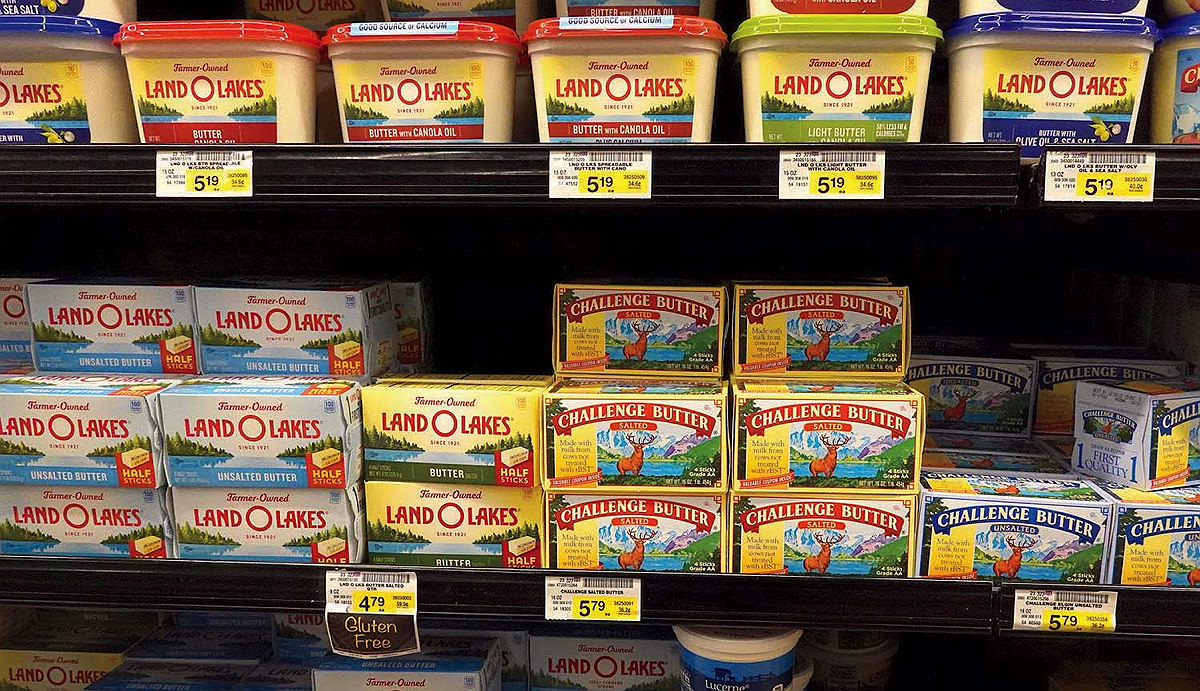
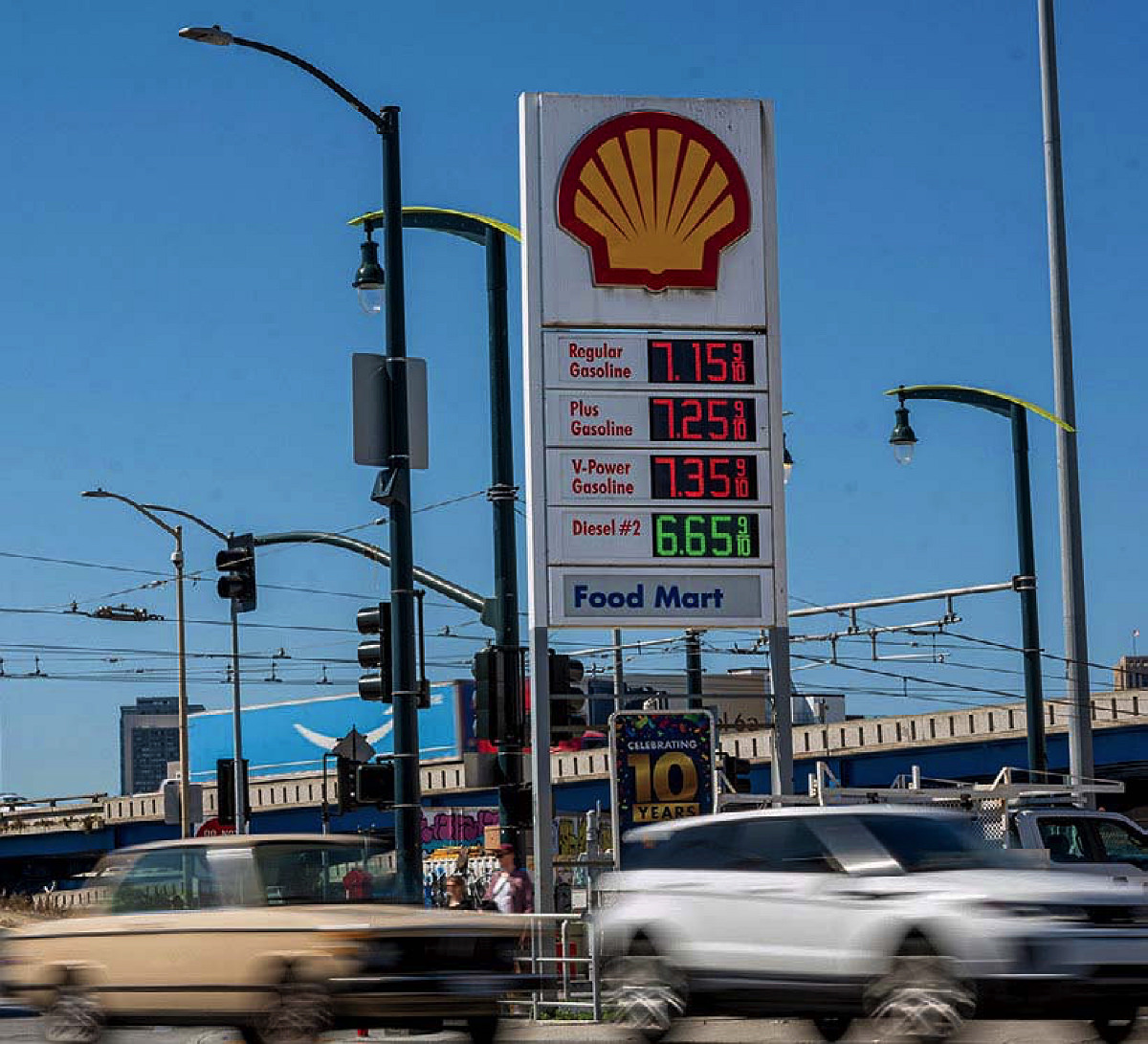
Food and energy prices have been volatile due to supply chain kinks and the war in Ukraine. But such inflation typically results in little pass-through to the rest of the economy.
Top photograph by Scott Olson/Getty Images; bottom photograph by David Paul Morris/Bloomberg via Getty Images
“The good news,” says professor of the practice of economics and of the practice of public policy Karen Dynan, “is that the pandemic recession did not create a lot of hardship, even though we saw a massive job loss, and that is because of the vigorous fiscal response.” The successive rounds of trillion-dollar emergency federal spending replaced a lot of lost income and shored up public finances at the state and local level. “It took us 10 years to recover from the Great Recession,” she points out, “partly because so many households were wiped out financially,” imposing long-lasting hardship on millions of families. “That didn’t happen this time,” says Dynan, who has served as Assistant Secretary at the U.S. Treasury Department, among other high-level federal appointments, and is an expert on consumer spending and saving behavior, household finances, and macroeconomic policy. Assessing the pandemic period, she continues, “When you look at people’s finances you see a lot of extra savings, and it’s not just the rich people who have more wealth. Families in the lower part of the distribution, who normally struggle to save, have a little more in the bank than they typically would.”
The bad news, she says, “is because we came out of the recession at a time when the economy was having difficulty revving up, we created this inflation pressure.” Monetary policy is not the only tool for relieving inflation pressure. Fiscal policies, enacted by Congress, can also be used to curb demand for goods and services. But Dynan argues that given inflation or recession, it is the Federal Reserve’s responsibility to respond. Fiscal policies are tough to enact, slow to take effect, and very hard to reverse, she says. “If you raise taxes, or spend money to train workers to ease labor shortages, and it turns out that your inflation forecast was wrong, it may be very hard to legislate the undoing of that. Monetary policy is much more nimble.”
“This is a delicate situation. We need to move very slowly with both levers. You’re putting on the brakes, and don’t know where you are going to be in a year.”
Rogoff cautions that with either policy tool—monetary or fiscal— “this is a delicate situation. We need to move very slowly with both levers. You’re putting on the brakes, and you don’t know where you’re going to be in a year. It would be very easy for the Fed to overshoot and cause a more severe recession.” As for fiscal policy, “Federal spending does need to slow down,” he says. “But again, you don’t want to do anything super fast.”
For the U.S. government, now facing a long-term paydown of the swollen national debt, there is both good news and bad. Although inflation leads to higher nominal interest rates on the national debt, it also increases nominal GDP, Dynan notes, making that debt relatively easier to shoulder. At the same time, inflation is eroding the value of foreign holdings of U.S. Treasuries and dollar cash to the tune of $600 billion. “We get a bonanza,” says Rogoff, “just the way we did in the 1970s.” Coauthor with Zombanakis professor of the international financial system Carmen Reinhart of the 2009 book This Time is Different: Eight Centuries of Financial Folly, he brings historical perspective to the current situation.“The problem,” he says, “is that we might have to pay this back in terms of higher interest rates in the future. Because to the extent we’re willing to inflate by 10 or 20 percent every once in a while,” altering investor expectations, “that’s ultimately going to get factored into interest rates.” After the runaway inflation of the 1970s, Rogoff notes, “we had to pay [relatively higher rates] in the 1980s and early 1990s. There will be a long-run consequence to this that has not appeared in the financial markets yet. But I think it’s a real concern. It’s no free lunch.”
And on the Horizon…Sovereign Debt Crises?
A slowing economy in China (see page 42) makes a near-term global recovery harder—but it also increases the risks of a sovereign-debt crisis among emerging markets and developing economies (EMDEs). So says Reinhart, who has just returned from a two-year stint as the World Bank’s chief economist. Between the early 2000s and 2015, EMDEs grew rapidly, fueled by double-digit annual growth in China. Many of these countries, she explains, export commodities such as oil and other natural resources—and China’s demand was voracious. But in 2015, as China’s growth slowed, commodity prices crashed. Moreover, China, which had been a major lender to EMDEs in dollar-denominated debt, began reining in its lending. The advent of COVID-19 in 2020, she says, initiated “the biggest collapse in global output since at least 1900.” Ninety percent of countries had a decline in per capita GDP exceeding the shares recorded during World War I, the Great Depression, or World War II.
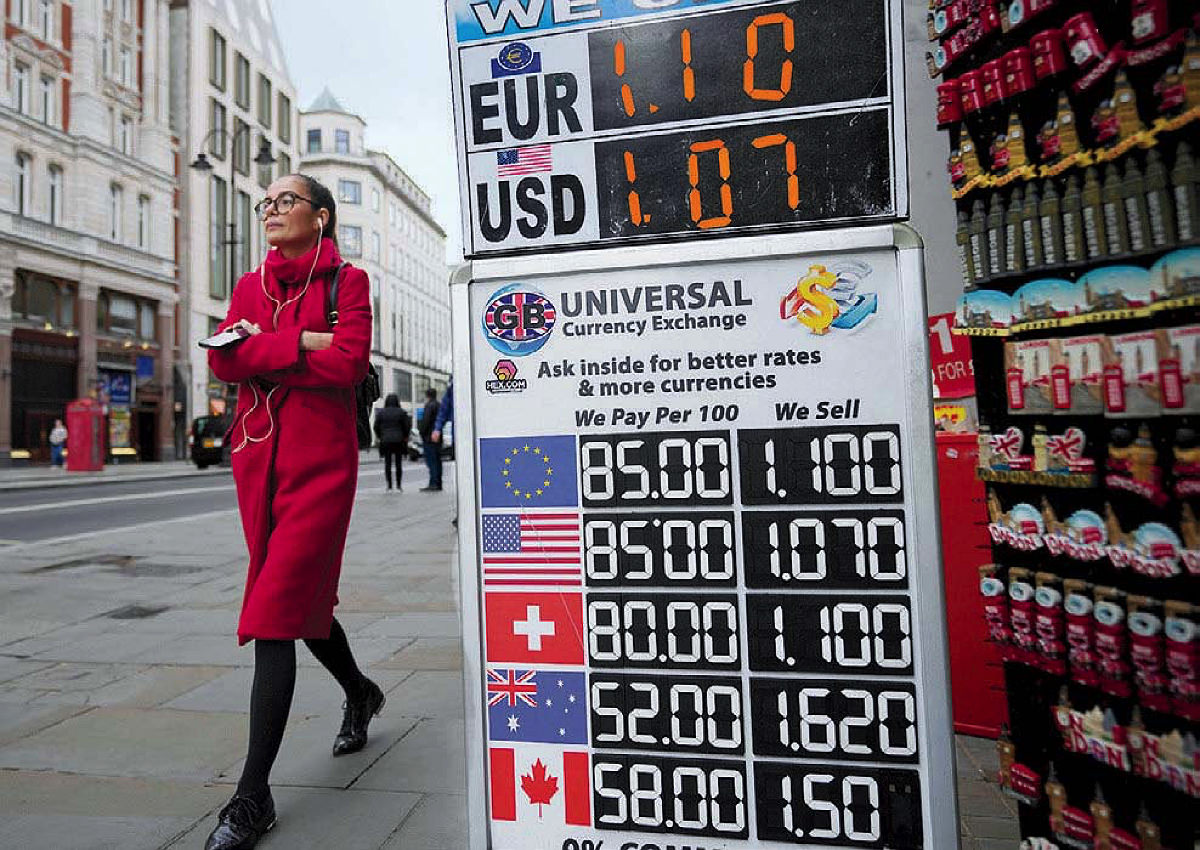
The Fed’s efforts to fight inflation by raising interest rates have strengthened the dollar. A Euro is worth less than a greenback, and the pound sterling is under pressure.
Photograph by Frank Augstein/Associated Press
Rising rates, driven by the U.S. central bank’s inflation-fighting efforts, could push many emerging and developing economies into crisis. When Federal Reserve chairman Paul Volcker raised rates to record levels to quell record inflation in the early 1980s, Frieden recalls, that “was a big contributing factor to the Latin American debt crisis.” Changes in how developing countries borrow suggest a lesser threat today, he notes, but some will struggle to service their existing debt—and a few, like Sri Lanka, are already in economic crisis, devastating their populations.
Reinhart notes that “Even before the Russia-Ukraine war and the spike in inflation and the Fed hiking rates, more than 50 percent of low-income countries were either in debt distress” or at high risk of a debt crisis: “It’s not a hypothetical.” Given the rising costs of food, fuel, and interest on their countries’ national debt, billions of people in the least developed economies are likely to suffer. These crises will not be reflected in New York stock market prices, nor will they affect advanced economies generally. But they demand humanitarian attention. During the financial crisis of 2008-2009, China was still growing at a double-digit pace. “Now, China is slowing, the U.S. faces the possibility of recession,” and Europe is at high risk of recession. “There is no obvious engine of global growth,” she says, “looking out into 2023”—and the poorer parts of the world will suffer.
Even if the domestic stakes are less immediately threatening, U.S. public debt has never been higher as a percentage of GDP than it was in 2021, Reinhart’s data shows. As she told an audience at the World Bank Group in June, to bring those debt levels down, “It is difficult to envision scenarios that do not involve higher taxes, including the inflation tax.” Inflation erodes the value of the national debt, she explains, but is, in effect, a regressive tax: everyone bears the higher costs, but as a percentage of income, the poor, struggling with the rising price of food and other essentials, pay the most.
* * *
If the Federal Reserve is serious about reducing inflation in the United States, Reinhart observes, rates will have to rise above the inflation rate (there is no consensus about how much higher they must be). Right now, “Real interest rates are still negative,” she points out: loans can be had at interest rates well below the rate of inflation—extending the “longest period of sustained negative interest rates in the U.S. since 1870.” The longer this continues, the more persistent it becomes, she adds. “We’ve all had real wage cuts” because compensation increases have not kept pace with rising consumer prices. “So the idea that workers going forward are not going to demand higher wages is overly optimistic.” Speaking from her extensive study of past financial crises, and broad experience in the governance of global financial institutions, she notes, “A significant, common policy mistake is to convince yourself that a bad shock will go away on its own, that it’s transitory.”
While both the Federal Reserve and the European Central Bank have begun raising rates aggressively, Reinhart is not yet impressed. “It’s one thing to be gung-ho about inflation reduction when the economy is still doing well,” she says. When signs of recession start to appear, and job losses create real hardship for millions of Americans, “that’s when the commitment of the central banks will really be put to the test.”
Most economists think it is still possible for the United States to avoid a deep contraction because there is so much pent-up demand in the developed world. Four percent inflation and a recession of perhaps six to nine months might be expected. But a fresh geopolitical disruption could easily derail that forecast.
Says Rogoff, “The problems we’re facing at the moment are a little bit of a rich person’s dilemma. If we were still in the pandemic, we wouldn’t be worrying about inflation, we’d be worrying about a million other things. And if you had asked a group of economists in March or April of 2020 where we were going to be today, and told them, ‘We’re going to have a terrific recovery, but the price level is going to be 10 or 15 percent higher,’ I think a lot of them would have said, ‘Go for it. That’s a win.’ But it’s hard to put these things in perspective.”
